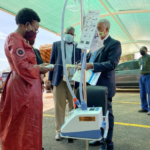Since an Ebola outbreak was declared in Uganda on 20 September, health assistant Nyangoma Kirrungi has been on the frontline of the country’s response day in and day out, working as a contact tracer in Madudu sub-county, one of the areas affected by the outbreak.
With support from World Health Organization (WHO) and partners, the Ugandan Ministry of Health has trained and deployed around 300 contact tracers like Kirrungi, who play a critical role as the country looks to curb the spread of the disease.
As part of surveillance team, Kirrungi follows up an average of 40 contacts a day. “I work closely with the investigation unit,” she explains. “Once they record a confirmed case of Ebola, my team and I go to the field to follow up with the patient’s contacts to ensure that they are symptom-free and then we remain on alert to identify and report symptoms should they develop.”
According to Dr Bernard Logouomo, the Ministry of Health Surveillance Team Lead in Mubende District, another Ebola-hit area in the country, contact tracing is key to ending the outbreak. “When the community cooperates in the response and contacts are identified, it becomes easier to contain the disease,” he says.
Contact tracers follow a questionnaire designed to assess if a contact has Ebola symptoms. Every contact tracer works with a maximum of 10 village health workers, who are volunteers trained in diseases surveillance. Recruited by communities, village health teams help build trust and overcome fears among responders.
In addition to the deployment of contact tracers, two hotlines were created for communities to report suspected cases. Investigators follow a list of questions designed to assess the need to dispatch an ambulance or a clinical officer. Once a case in confirmed, a case investigation team establishes a list of contacts, depending on where the patient was likely to have been infected and who they may have met afterwards.
After contacts have been located and screened, village health teams take over to monitor them for any symptoms for 21 days ‒ the Ebola incubation period. Beyond this important supporting role, these teams also provide invaluable assistance in raising awareness of the disease within their communities. Since the start of the epidemic, the Ministry of Health has trained over 1200 village health team members, also with support from WHO and partners.
With only 25% of contacts followed up every day in the first days of the outbreak, contact tracing quickly improved. By mid-October, nearly 94% of 552 contacts were seen and monitored daily for 21 days.
Lydia Nasamba, a market trader and a resident of Madudu, has been a member of a local village health team for more than eight years. “Every day at 3pm, I go to the sub-county community radio station, where I raise awareness about Ebola ‒ its symptoms, preventive measures and how to report cases,” she says. “After that, I visit the identified contacts in my community to check their health status.”
While the contribution of people like Kirrungi and Nasamba is a crucial component of Uganda’s Ebola response, they face numerous daily challenges, including a lack of personal protective equipment and reliable transport. Contact tracers are often faced with community members’ fear of being stigmatized or isolated in a health facility, which puts people’s livelihood at risk. Contacts may also not be home when contact tracers visit them, which makes it difficult to monitor them on daily basis.
With support from the United States Agency for International Development and the Norwegian government, WHO has provided four Ebola kits to Mubende Regional Hospital and redeployed 108 technical staff to assist with case management, risk communication, community engagement and laboratory testing.
Back on the ground in Madudu, nothing will deter Kirrungi from the task at hand. “Since I have been involved in the Ebola response, I feel like I am saving lives. I have learned that if all contacts are identified and treated, the disease will disappear,” she says. “That’s what motivates me every day.”







